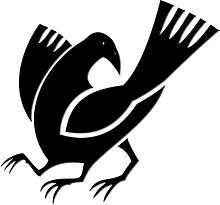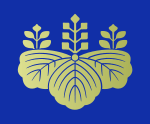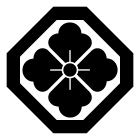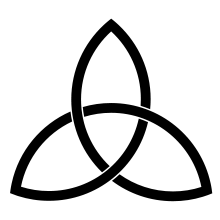Mon (emblem)


Mon (紋), also monshō (紋章), mondokoro (紋所), and kamon (家紋), are Japanese emblems used to decorate and identify an individual or family. While mon is an encompassing term that may refer to any such device, kamon and mondokoro refer specifically to emblems used to identify a family. An authoritative mon reference compiles Japan's 241 general categories of mon based on structural resemblance (a single mon may belong to multiple categories), with 5116 distinct individual mon (it is however well acknowledged that there exist lost or obscure mon that are not in this compilation).[1][2]
The devices are similar to the badges and coats of arms in European heraldic tradition, which likewise are used to identify individuals and families. Mon are often referred to as crests in Western literature, another European heraldic device similar to the mon in function.
History

Mon may have originated as fabric patterns to be used on clothes in order to distinguish individuals or signify membership of a specific clan or organization. By the twelfth century, sources give a clear indication that heraldry had been implemented as a distinguishing feature, especially for use in battle. It is seen on flags, tents, and equipment.
Like European heraldry, mon were initially held only by aristocratic families, and were gradually adapted by commoners. On the battlefield, mon served as army standards, even though this usage was not universal and uniquely designed army standards were just as common as mon-based standards (cf. sashimono, uma-jirushi). Mon were also adapted by various organizations, such as merchant and artisan guilds, temples and shrines, theater troupes and even criminal gangs. In an illiterate society, they served as useful symbols for recognition.
Japanese traditional formal attire generally displays the mon of the wearer. Commoners without mon often used those of their patron or the organization they belonged to. In cases when none of those were available, they sometimes used one of the few mon which were seen as "vulgar", or invented or adapted whatever mon they wished, passing it on to their descendants. It was not uncommon for shops, and therefore shop-owners, to develop mon to identify themselves.
Rules regulating the choice and use of mon were somewhat limited, though the selection of mon was generally determined by social customs. It was considered improper to use a mon that was known to be held by someone else, and offensive to use a mon that was held by someone of a high rank. When mon came into conflict, the lower-ranked person sometimes changed their mon to avoid offending their superior. The mon held by the ruling clans of Japan, such as Tokugawa's hollyhock mon and the Emperor's chrysanthemum mon, were legally protected from unauthorized usage.
Occasionally, patron clans granted the use of their mon to their retainers as a reward. Similar to the granting of the patron's surnames, this was considered a very high honor. Alternatively, the patron clan may have added elements of its mon to that of its retainer, or choose a completely different mon for them.
Design
There are no set rules in the design of a mon. Most consist of a roundel encircling a figure of plant, animal, man-made, natural or celestial objects, all abstracted to various degrees. Religious symbols, geometric shapes and kanji were commonly used as well.
Similar to the blazon in European heraldry, mon are also named by the content of the design, even though there is no set rule for such names. Unlike in European heraldry, however, this "blazon" is not prescriptive—the depiction of a mon does not follow the name—instead the names only serve to describe the mon. The pictorial depictions of the mon are not formalized and small variations of what is supposed to be the same mon can sometimes be seen, but the designs are for the most part standardized through time and tradition.
The degree of variation tolerated differ from mon to mon as well. For example, the paulownia crest with 5-7-5 leaves is reserved for the prime minister, whereas paulownia with fewer leaves could be used by anyone. The imperial chrysanthemum also specifies 16 petals, whereas chrysanthemum with fewer petals are used by other lesser imperial family members.
Japanese heraldry does not have a cadency or quartering system, but it is not uncommon for cadet branches of a family to choose a slightly different mon from the senior branch. Each princely family (Shinnōke), for example, uses a modified chrysanthemum crest as their mon. Mon holders may also combine their mon with that of their patron, benefactor or spouse, sometimes creating increasingly complicated designs.
Mon are essentially monochrome; the color does not constitute part of the design and they may be drawn in any color.
Modern usage

Virtually all modern Japanese families have a mon, but unlike before the Meiji Restoration when rigid social divisions existed, mon play a more specialized role in everyday life. On occasions when the use of a mon is required, one can try to look up their families in the temple registries of their ancestral hometown or consult one of the many genealogical publications available. Many websites also offer mon lookup services. Professional wedding planners, undertakers and other "ritual masters" may also offer guidance on finding the proper mon.
Mon are seen widely on stores and shops engaged in traditional crafts and specialties. They are favored by sushi restaurants, which often incorporate a mon into their logos. Mon designs can even be seen on the ceramic roof tiles of older houses. Mon designs frequently decorate senbei, sake, tofu and other packaging for food products to lend them an air of elegance, refinement and tradition. The paulownia mon appears on the obverse side of the 500 yen coin.
Items symbolizing family crafts, arts or professions were often chosen as a mon. A fan design might be chosen by a geisha. A woman may still wear her maiden mon if she wishes and pass it on to her daughters; she does not have to adopt her husband's or father's mon. Flowers, trees, plants and birds are also common elements of mon designs.[3]
Mon add formality to a kimono. A kimono may have one, three or five mon. The mon themselves can be either formal or informal, depending on the formality of the kimono. Very formal kimono display more mon, frequently in a manner that makes them more conspicuous. In the dress of the ruling class, the mon could be found on both sides of the chest, on each sleeve, and in the middle of the back. On the armor of a warrior, it might be found on the kabuto (helmet), on the do (breast plate), and on flags and various other places. Mon also adorned coffers, tents, fans and other items of importance.
As in the past, modern mon are not regulated by law, with the exception of the Imperial Chrysanthemum, which doubles as the national emblem, and the paulownia, which is the mon of the office of prime minister and also serves as the emblem of the cabinet and government (see national seals of Japan for further information). Some local governments and associations may use a mon as their logo or trademark, thus enjoying its traditional protection, but otherwise mon are not recognized by law. One of the best known examples of a mon serving as a corporate logo is that of Mitsubishi, a name meaning "three lozenges" (occasionally translated as "three water chestnuts"), which are represented as rhombuses.[4] Another example of corporate use is the logo for the famous soy sauce maker Kikkoman, which uses the family mon of the founder,[5] and finally, the logo of music instrument/equipment and motorcycle builder Yamaha, which shows three tuning forks interlocked into the shape of a capital Y in reference to both their name and the origin of the company.[6]
Gallery of representative kamon by theme
Animal motif
 Agehanochō, the Swallowtail butterfly crest of the Taira clan
Agehanochō, the Swallowtail butterfly crest of the Taira clan Kiyobu Chō (Butterfly)
Kiyobu Chō (Butterfly) Mythical Three-legged crow Yatagarasu
Mythical Three-legged crow Yatagarasu Crane crest of Mori clan similar to Japan Airlines
Crane crest of Mori clan similar to Japan Airlines Triple crane crest
Triple crane crest Quintuple Chidori bird crest
Quintuple Chidori bird crest Mitsu uroko, three fish-scales, of Hōjō clan
Mitsu uroko, three fish-scales, of Hōjō clan Maruni Chigai Takanoha, the crossing pair of hawk feathers in circle
Maruni Chigai Takanoha, the crossing pair of hawk feathers in circle 3 monkey crest
3 monkey crest Kotobuki Ebi Shrimp emblem
Kotobuki Ebi Shrimp emblem
Flora motif
 This paulownia flower pattern (go-shichi-no-kiri) is the symbol of the Office of the Prime Minister of Japan and Toyotomi Clan
This paulownia flower pattern (go-shichi-no-kiri) is the symbol of the Office of the Prime Minister of Japan and Toyotomi Clan Daki Myōga (Japanese ginger)
Daki Myōga (Japanese ginger)
 Maruni Mitsu(ba) Aoi, the hollyhock crest of the Tokugawa clan
Maruni Mitsu(ba) Aoi, the hollyhock crest of the Tokugawa clan Maruni Sumitate Yotsumei Circle and Four Eyelets on the Edge of the Uda Genji
Maruni Sumitate Yotsumei Circle and Four Eyelets on the Edge of the Uda Genji
 Sumikirikakuni Hanakaku
Sumikirikakuni Hanakaku Tachi Omodaka or Upright Threeleaf Arrowhead (Sagittaria trifolia)
Tachi Omodaka or Upright Threeleaf Arrowhead (Sagittaria trifolia) Triple Pine Tree Maruni Hidari Sangaimatsu of Hira clan, member of Taira clan (Heike)
Triple Pine Tree Maruni Hidari Sangaimatsu of Hira clan, member of Taira clan (Heike) Jūroku Uragiku, crest of the Hirohata clan
Jūroku Uragiku, crest of the Hirohata clan Mitsugumi Tachibana (Triple Mandarin orange)
Mitsugumi Tachibana (Triple Mandarin orange) Hana Wachigai, the device of the Izumo Genji clans(Oki, Enya, Takaoka)
Hana Wachigai, the device of the Izumo Genji clans(Oki, Enya, Takaoka) Matsudaira clan gold leaf emblazoned hollyhock
Matsudaira clan gold leaf emblazoned hollyhock
 Sparrows and Bamboo Take ni Suzume of the Date clan
Sparrows and Bamboo Take ni Suzume of the Date clan
Tools motif
 6 coin crest of Sanada clan.
6 coin crest of Sanada clan.
 Tang Dynasty style hand fan crest
Tang Dynasty style hand fan crest Wheel motif of Genji clan
Wheel motif of Genji clan Gion Mamori shield motif
Gion Mamori shield motif
 Nakagawake Kurusu (the cross of Nakagawa clan)
Nakagawake Kurusu (the cross of Nakagawa clan) Nail Puller Kuginuki
Nail Puller Kuginuki
Other motifs
 Yamabishi, the crest of the Yamaguchi-gumi yakuza clan
Yamabishi, the crest of the Yamaguchi-gumi yakuza clan Chigai Bishi
Chigai Bishi Eyes motif Janome Shichiyo
Eyes motif Janome Shichiyo Marunouchi Mitsuhikiryō
Marunouchi Mitsuhikiryō Mitsu Irekomasu, the crest of the Ichikawa family of kabuki actors
Mitsu Irekomasu, the crest of the Ichikawa family of kabuki actors Musubi Mitsugashiwa (a triquetra)
Musubi Mitsugashiwa (a triquetra) Suzugohei
Suzugohei.svg.png) Emblem of Itsukushima Shrine in Hiroshima
Emblem of Itsukushima Shrine in Hiroshima Triple Star Emblem of Mitsuboshi, of Watanabe clan and Mori clan.
Triple Star Emblem of Mitsuboshi, of Watanabe clan and Mori clan..svg.png) 9 tomoe emblem
9 tomoe emblem Nitōnami Wave emblem of Saito clan.
Nitōnami Wave emblem of Saito clan._1.svg.png) Origami paper crane emblem
Origami paper crane emblem Well motif similar to crest of Sumitomo Group.
Well motif similar to crest of Sumitomo Group. Japanese Shinto torii shrine crest.
Japanese Shinto torii shrine crest. Buddhist Swastika crest.
Buddhist Swastika crest. Chinese character motif crest of Ishida Mitsunari.
Chinese character motif crest of Ishida Mitsunari.
See also
References
- ↑ 日本の家紋大全 梧桐書院 ISBN 434003102X
- ↑ Some 6939 mon are listed here.
- ↑ Nakano, Mas. "Family Crests - Mon". Japan-Society.org. Japan Society of San Diego and Tijuana. Retrieved 4 June 2013.
- ↑ "The Mitsubishi Mark". Mitsubishi.com. 2008. Accessed 10 August 2008.
- ↑ My family's kamon and history
- ↑ Yamaha's logo
External links
| Wikimedia Commons has media related to Heraldry of Japan. |
| Wikimedia Commons has media related to Mon (emblem). |
- Website offering free EPS files of kamon, sorted by category—click on the center (再生) to start (English) (Japanese)
- Website offering free Illustrator (Ai) files of kamon, classified by category (English)
- Hidaka Family Emblems: A lantern-maker's website that features illustrations of many kamon
- The Japan Society of San Diego and Tijuana's page on kamon
- Page with generic descriptions and links to 100 mon (Japanese)
- Kamon World—Encyclopedia (Japanese)
- Onnamon—Encyclopedia with emphasis on female kamon (Japanese)
- Mondokoro—Kamon search by family name (Japanese)
- Nihon Kamon Kenkyukai—Japan Kamon Society (Japanese)
